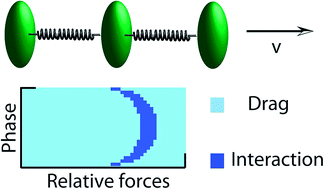Forces and shapes as determinants of micro-swimming: effect on synchronisation and the utilisation of drag†
Abstract
In this analytical study we demonstrate the richness of behaviour exhibited by bead-spring micro-swimmers, both in terms of known yet not fully explained effects such as synchronisation, and hitherto undiscovered phenomena such as the existence of two transport regimes where the swimmer shape has fundamentally different effects on the velocity. For this purpose we employ a micro-swimmer model composed of three arbitrarily-shaped rigid beads connected linearly by two springs. By analysing this swimmer in terms of the forces on the different beads, we determine the optimal kinematic parameters for sinusoidal driving, and also explain the pusher/puller nature of the swimmer. Moreover, we show that the phase difference between the swimmer's arms automatically attains values which maximise the swimming speed for a large region of the parameter space. Apart from this, we determine precisely the optimal bead shapes that maximise the velocity when the beads are constrained to be ellipsoids of a constant volume or surface area. On doing so, we discover the surprising existence of the aforementioned transport regimes in micro-swimming, where the motion is dominated by either a reduction of the drag force opposing the beads, or by the hydrodynamic interaction amongst them. Under some conditions, these regimes lead to counter-intuitive effects such as the most streamlined shapes forming locally the slowest swimmers.


 Please wait while we load your content...
Please wait while we load your content...